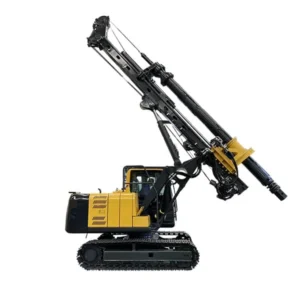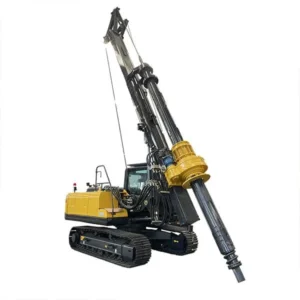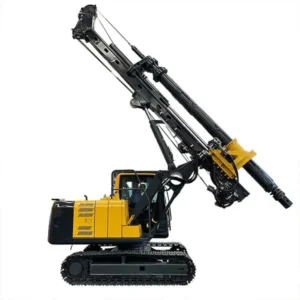Introduction
Selecting the right drill rig rotary system is crucial for the success of your drilling project. Whether you are working in mining, construction, or oil and gas, the right equipment can make a significant difference in efficiency, cost-effectiveness, and overall project outcomes. This comprehensive guide will walk you through the key considerations and steps in choosing the ideal drill rig rotary system for your specific needs.
Types of Drill Rig Rotary Systems

Drill rig rotary systems can be broadly categorized into two main types:
Tophead Drive Rotary Systems: In this system, the power source, typically an electric motor or hydraulic motor, is located at the top of the drill mast. The torque is transmitted to the drill bit through a series of shafts, gears, and a kelly bar, which rotates the drill string and bit.
Table Drive Rotary Systems: In this system, the power source is located at the base of the drill mast, typically connected to a turntable. The torque is transferred to the drill bit through a rotary table, which rotates the drill string and bit.
Key Components of a Drill Rig Rotary System
The primary components of a drill rig rotary system include:
Power Source: The power source provides the energy to drive the rotary system, typically an electric motor, hydraulic motor, or diesel engine.
Transmission: The transmission transfers the torque from the power source to the rotating components of the system. It may consist of gears, shafts, and couplings.
Mast or Tower: The mast or tower supports the weight of the drill string and provides a vertical guide for the drill bit.
Rotary Table or Tophead: The rotary table or tophead rotates the drill string and bit, providing the drilling action.
Kelly Bar or Swivel: The kelly bar or swivel connects the tophead to the drill string, allowing for rotation and vertical movement of the drill bit.
Drill String: The drill string is a series of connected drill pipes that transmit torque and rotation from the tophead to the drill bit.
Drill Bit: The drill bit is the cutting tool that breaks up the rock or soil formation.
Factors to Consider When Choosing a Drill Rig Rotary System

Selecting the right drill rig rotary system for your project depends on several critical factors:
Drilling Depth and Diameter: The depth and diameter of the boreholes required will influence the size and capacity of the rotary system.
Soil and Rock Formations: The type of soil or rock formation to be drilled through will affect the torque and power requirements of the system.
Drilling Method: The chosen drilling method, such as rotary drilling, percussion drilling, or reverse circulation drilling, will determine the compatibility of the rotary system.
Rig Type and Capacity: The size and capacity of the drill rig itself will influence the compatibility and performance of the rotary system.
Cost and Efficiency: The cost of the rotary system and its operational efficiency should be considered in relation to the project’s budget and timeline.
Table of Common Drill Rig Rotary System Applications
| Application | Rotary System Type |
|---|---|
| Water Well Drilling | Tophead Drive, Table Drive |
| Oil and Gas Exploration | Tophead Drive, Table Drive |
| Geotechnical Investigation | Tophead Drive, Table Drive |
| Mineral Exploration | Tophead Drive, Table Drive |
| Foundation Drilling | Tophead Drive, Table Drive |
| Environmental Remediation | Tophead Drive, Table Drive |
Conclusion
Choosing the right drill rig rotary system for your project involves understanding your specific needs, evaluating different types of rigs and their components, considering power sources and budget constraints, and selecting a reputable manufacturer. By carefully considering these factors, you can ensure the success of your drilling project, enhance efficiency, and achieve optimal results.
FAQ
Q: What is the main difference between land rigs and offshore rigs?
A: Land rigs are designed for onshore drilling projects and are typically more mobile and easier to set up. Offshore rigs are built for drilling in the ocean and are often larger, more complex, and designed to withstand harsh marine environments.
Q: How do I determine the appropriate power source for my drill rig rotary system?
A: The choice of power source depends on your project’s location, environmental considerations, and power availability. Diesel engines are common for their reliability, electric motors are efficient and environmentally friendly, and hydraulic systems offer precise control.
Q: What are the maintenance requirements for a drill rig rotary system?
A: Regular maintenance includes checking and replacing worn parts, lubricating moving components, inspecting the drill pipe and bit for damage, and ensuring that the power source is functioning correctly. Scheduled maintenance and adherence to manufacturer guidelines are crucial for optimal performance and longevity.
Q: Can I use the same drill rig rotary system for different types of drilling?
A: Some drill rig rotary systems are versatile and can be used for various drilling types, including vertical, horizontal, and directional drilling. However, it’s essential to ensure that the system is compatible with the specific requirements of each project and equipped with the appropriate components and accessories.
Q: How can I improve the efficiency of my drilling operations with a drill rig rotary system?
A: To enhance efficiency, ensure that you select the right system for your project, maintain the equipment regularly, use high-quality drill bits and pipes, train your operators thoroughly, and optimize your drilling techniques based on the specific conditions and requirements of your project.









-150x150.webp)
